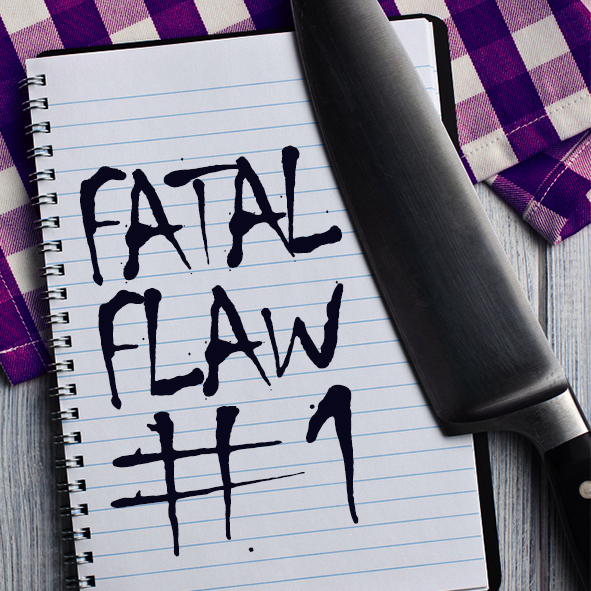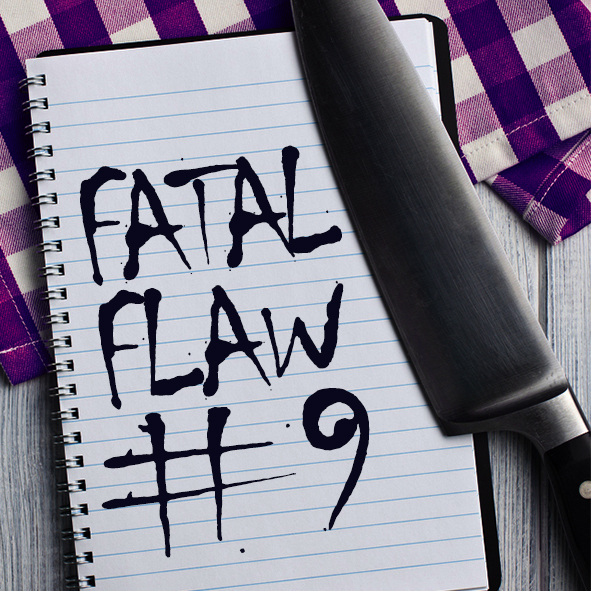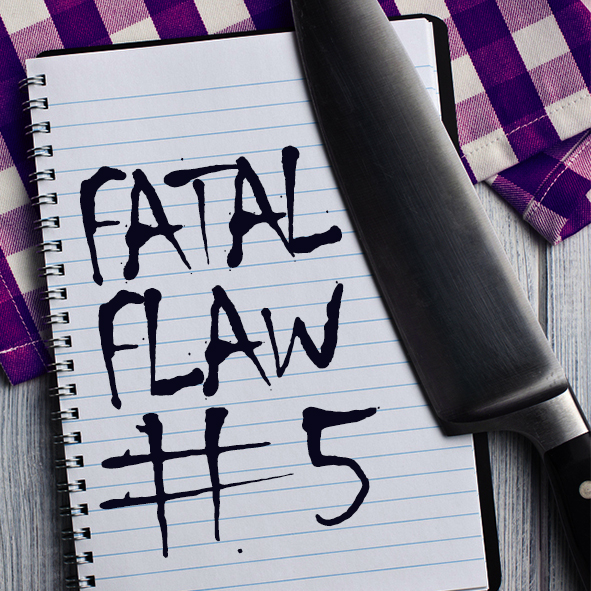The Devil’s in the Details
We’re continuing our look at Fatal Flaw # 1: Overwriting. Fiction writers often overwrite, and have trouble seeing how this manifests in their prose. Last week we looked at wordiness and redundancy. This week editor Linda Clare explores this topic further to help you determine which details in your scenes are important and which can be tossed.
The world is full of details—and good writers notice them perpetually. Yet when you introduce your created world to readers, it’s easy to get carried away. Let’s take a look at how overwriting, or including too many details, can derail your scenes and lose readers.
You Are the Manager
As a fiction writer, you are a manager. You hold the power to guide your readers, managing their attention and memory. By stressing a certain detail or event, you are managing readers by sending the message: “Pay attention to this. Remember this.”
If you attempt to write a scene that includes a blow-by-blow account of what is happening, it may mirror real life, but readers will not know which details matter to the story and which are incidental. If you overload readers with stimuli, they won’t know what to pay attention to and what to ignore. If you understand this, it’s easier to remind yourself to write only what the readers need to know, with a few “extra sprinkles” of concrete sensory detail (CSD) to help make the scene believable.
Write the Right Details
So which of these details do you choose to include in your scene? In order to create a believable world for readers, your scenes must be more realistic than the false building fronts of a Hollywood set. Details are vital to believability. If you only paint your scene in general or vague words, readers are less likely to remain engaged.
How do you know what to include and what to leave out? Think of your story as a road that runs through a city. There are lots of other roads, but only this one road leads readers to their destination: the story outcome. Along the way readers might smell the air or see the trees whizzing past, but they keep their eyes on the road.
The “extra” details you provide should add to the experience of the story in a sensory-emotional way. These details need to be connected to what your main character is after, whether it’s a new love, a killer, or a pot of gold. All other details are of little importance to the story and usually can be safely eliminated.
Leave Out the Boring Stuff
Elmore Leonard famously said, “Leave out the boring parts that readers skip.” Many times these “boring” bits fall into the categories of stage directions, repetitions, or expositions. Stage directions that mimic real life can be insufferable for readers.
For instance, let’s say you write a scene about a meeting your character must attend. In real life these meetings are often long and boring and filled with missteps. There’s a computer glitch or someone is late. People drone on and on. You get the idea. The key to writing a scene with any extended boring or otherwise mundane situation is to give the reader the feeling of boring or repetitive without actually making readers suffer through the actual boring thing. For instance, if your scene is about a child whining in the grocery store, you can give the illusion of this without recording every line of dialog and action.
The Rule of Three
Something I call the Rule of Three can be helpful in deciding how much detail to include. In general, give readers three details of something important that you need readers to remember. These should be concrete and sensory—meaning they are connected in some way with the five senses and/or very specific (e.g., a cherry-red Camaro instead of a red car). You can also use the Rule of Three to give the illusion of a boring or unimportant action or dialog.
Going back to the whiny child in the store, you might write three lines or exchanges of dialog: “Mommy, can I have that Sugary Cereal?” “No, you can have plain Cheerios.” “But all the kids get Sugary Cereal!” “No, not all kids get it. Besides, you’re not all kids.” “Whhhhyyyy can’t I have it Mommy? Pleeeaaassse?” “I said no and that’s that.”
We understand that these types of exchanges typically go on and on. But to force your readers to endure the real-life version is cruel and will just drive them away. The example is plenty for readers to get the idea, the feeling, without having to suffer.
Now let’s look at an example of overwriting:
BEFORE:
Tiffany decided to encourage the design team to continue to keep up their good job. They had been working hard and accomplished a lot. That was part of her job—encouraging her team.
“Now, team,” she told them at the meeting that had just started at three o’clock in the afternoon in the large corner office of their building, “we have just come up with a lot of exciting ideas for you to work on. I know you are already working hard and staying late, and I’m not looking to add to your workload. Therefore, I’ve asked Bill from merchandising to join us to share something we’ve been working on. We’ve developed a new strategy for our product offering that will be better for our business and make better use of the talent on this team. I know you are all very talented, and I want to encourage you. But we aren’t using everyone’s talents to the full or in the best way.”
Bill came in and said hi to everyone. Then he plugged in his laptop and a PowerPoint presentation came up on the screen. He pressed buttons and skipped through some of the slides until he came to the ones he wanted to show everyone.
“Here are some key facts that Tiffany and I wanted to share with you.” A chart showed that the number of styles from Women’s Apparel had increased on average 15 percent season to season. Another graph showed their best-selling products had the highest out-of-stocks. The last graph showed that margins had been on a straight line decline for the past few years. Tiffany thought Bill’s presentation was well done. He really focused on the things that her team needed to pay attention to, such as which styles had increased in sales and which were their best-selling items.
Tiffany said, “This analysis shows we’re making a lot more stuff every year. But, we’re not making enough of the best stuff to satisfy demand. And despite all our hard work, we aren’t making money. The big conclusion? More stuff doesn’t mean better business. We need to make fewer, better things that sell. And that means a more manageable workload for you.”
Heads nodded all around.
Were you bored? Did you really need all those details? Now, let’s look at a more focused, tight, and clean version:
AFTER:
Tiffany encouraged her design team to keep up the good work. They’d been diligent and accomplished a lot.
“Now, team,” she told them at the three o’clock meeting, “we’ve just come up with a lot of exciting ideas. You’re already working hard and staying late, and I’m not looking to add to your workload. I’ve asked Bill from merchandising to share a new strategy that will be better for everyone and utilize your talents more effectively.
Bill greeted the group and brought up his presentation on the screen. “Here are some key facts.” He pointed to a series of graphs. Women’s Apparel styles had increased an average fifteen percent increase, best-selling products had the highest out-of-stocks rate, and margins had been on a straight-line decline for the past few years. Tiffany nodded and smiled at Bill. His presentation really focused on the things that her team needed to pay attention to.
Tiffany said, “We’re making a lot more stuff every year, but we’re not making enough of the best stuff to satisfy demand. And despite all our hard work, we aren’t making money. We need to make fewer, better things that sell. And that means a more manageable workload for you.”
Heads nodded all around.
The first thing you may notice is that the second version is far less wordy. Once we know what the scene is about, it’s not necessary to keep repeating words such as analysis, encouragement, or products. The people in the scene get it, and so do we.
And what about those boring missteps as Bill fumbles with his computer? These details might make for a comedy scene, but if they’re not central to the story, why torture readers unnecessarily? You might be able to use a bit of this if you put it into Tiffany’s (the POV) head: That Bill! Why can’t he get his act together? But in this example, the writer was only being faithful to nonessential details.
When you write scenes, do you worry that readers will not see the exact thing you imagine? If so, you may want to loosen your hold on the reins. As long as the story moves and is dramatizing what the story is about, you can safely allow readers to imagine these details any way they wish.
Your Turn:
What kinds of details do you think are the most important for readers to know? How do you tell if a detail is essential or just a boring addition?










I’d just like to add that the details you include should also depend on the POV character (unless you’re writing in omnipresent, which is rare these days). For example, if your POV character is a young single woman, if she walks into a crowded room, she’ll first notice all the handsome men. If a police officer walks in, he’ll notice the dangerous looking men first. The single woman would never notice that the fair haired cutie is carrying a concealed weapon (unless she’s a police officer as well 😉 ). An interior decorator might sooner notice that the curtains don’t match the sofa than any of the people in the room. It’s a great way to add characterisation to your characters by picking the details that are important to them and which they would sooner pay attention to, and leave out those they would rarely notice or care about.
Also, if your character is in a fight, he won’t notice many details. He won’t notice the model of the knife that’s about to stab him. The faster the scene, the less time your character has to notice the details. The slower the scene, on the other hand, the more time he has to pay attention to all those details. So, details are also a great way to slow down or speed up a scene.
Or, to use your example, if you’re going to use “Camaro” instead of “car” (which generally is the right thing to do) make sure first that your character is someone who can actually tell it’s a Camaro :).
Thanks for sharing that. Everything is experienced via the POV character, so what is noticed has to fit character. Great point.
A great point, Catie. Thanks. You’re so right–the details you choose should always be filtered through your POV character. Keep Writing! ~Linda
Too much detail does make a story drag . For me clothing details are boring. If there is a reason I need to know the exact style of a dress or the particular suit is one thing but sharing the detail of every dress and suit of every character is too much for me. Give a brief discription of the heroine’s dress so I get a feel of time and place and my imagination can takeover from there. That’s the beauty of story telling,the readers imagination. If you asked two different readers to describe a character or scene from the same book they would never be the same. That’s why some people are disappointed in the movie versions of their favorite books. The details are not as they imagined them.
Great post on details.
Hi Cindy,
I agree that too many fashion details make the story drag and let’s readers wonder what is important. Thanks for dropping by!
Keep Writing,
Linda
OOPs I meant lets not let’s! ~Linda
Wonderful and valuable advice offered here. Thanks so much for sharing! I’ve been freelance writing since 1983 and I’m always learning something new from your posts, which says a lot.
Keep the posts coming and I’ll keep forwarding and retweeting them.
Cheers!
S.J. Francis
SJ,
So glad you could use some of these tips. Let me know how they work for you, OK? Keep Writing,
Linda
Excellent points, Linda! I love the Rule of Three. When I was a beginning writer, I really held tight to the reins when it came to description. I knew what I saw, and I wanted my readers to see it just as I did. Now I realize that while description is important, there are also pros to allowing the reader some leeway in imagining the scene. Great advice!
Thanks, Christy,
We writers work so hard to let readers “see” our worlds, but as you said, if we hold too tight we’re forcing them and it often backfires. I also use the Rule of Three in dialog and flashbacks. I hope you’ll stayed tuned for more posts!
Keep Writing,
Linda
Great post! I am guilty of overwriting, especially the first draft.
One thing I have found to be useful when editing is distance. Initially, I started editing immediately I had the story ‘down’ – and struggled to know what to cut, and where to cut. Everything had too much importance in my ‘storytelling’ view.
Now, several months and much craft and tips-study later, I’ve gained enough distance to (hopefully) see things more from the readers’ perspective, and clarify which details are important, and which were simply me transferring my mind’s-eye narrative onto the page. Sure – some of them were great fun to write and helped ME build my worrld, but with distance, I think we also learn to trust the reader.
By learning to axe unnecessary detail, in turn we also allow the reader to trust us – that details we do include are there because they are important.
Piper,
One thing I’ve found helpful is to write a first draft by “junking it through,” as the famous writer Ken Kesey once said. Then I “let it rest” (at LEAST 24 hours, more if I’m not on deadline!) and then go into edit mode. As more time passes, more objectivity usually emerges, so we can edit fearlessly. Anne Lamott said, “First you get it down and then you fix it up.” That’s my method and it sounds as if it works for you too.
Keep Writing,
Linda
Too much detail does make a story drag . For me clothing details are boring. If there is a reason I need to know the exact style of a dress or the particular suit is one thing but sharing the detail of every dress and suit of every character is too much for me.
I have read some very involved descriptions by some prominent writers and find that all this extra writing just slows down a story. Some settings read like the directions to an illustrator for a graphic novel. I prefer to set the scene in brief and let the reader fill in the blanks. Theor own imagination helps to immerse them in the story being told. IMHO.